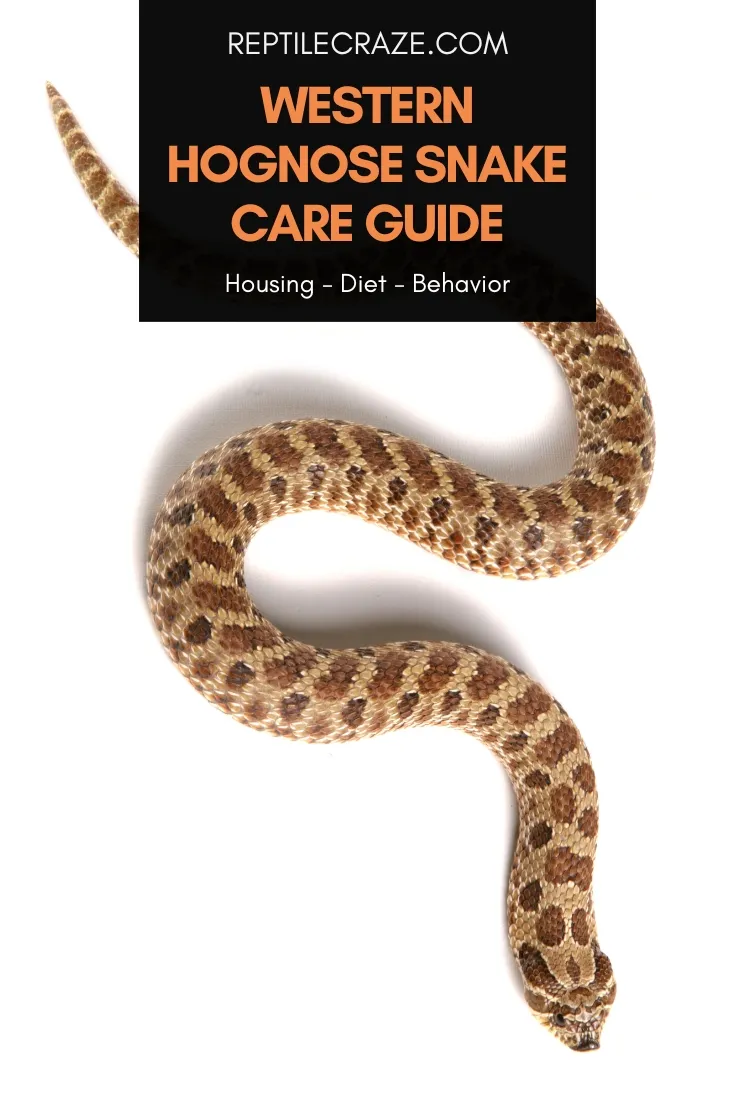
Western Hognose snakes are extremely popular as pet snakes. Practically anyone falls for their cute snouts and variety of morphs. Should a first-time snake owner get a western hognose snake? Do western hognose snakes stay small?
This article will discuss how to take care of a western hognose snake. We will discuss their behavior, how to set up their
Table of Contents
Western Hognose Snake Facts
| Scientific Name | Heterodon nasicus |
| Common Name | Western Hognose Snake |
| Average Adult Size | Male: 1.5-2 ft. (46-61 cm.) Female: 2.5-3 ft. (76-91 cm.) |
| Average Adult Weight | Male: 0.33-0.77 lbs. (150-350 g.) Female: 0.77-1.7 lbs. (350-750 g.) |
| Lifespan | 15-18 years |
| Natural Habitat | Grasslands, semi-deserts, and floodplains of the United States, Canada, and Northern Mexico |
| Enclosure Size | Juvenile: 10-gallon Adult male: 20-gallon Adult female: 40-gallon |
| Daytime Temperature | 75-85 F (24-29 C) |
| Nighttime Temperature | 65-75 F (18-24 C) |
| Humidity | 30-50% |
| Diet | rodents, toads, frogs, reptile eggs, lizards |
| Experience Level | Intermediate |
Where Do Western Hognose Snakes Live?
Western Hognoses live primarily in soils that have sand, soil, and gravel. They frequent grasslands, semi-deserts, river floodplains, prairies, and also semi-agricultural areas.
In the wild, they can be found in South Central Canada, Texas, New Mexico, South to Southeast Arizona, Mexico, and south of San Luis Potos. They tend to make their own burrows instead of seeking shelter in abandoned burrows.
Western Hognose Snake Appearance, Colors, and Morphs
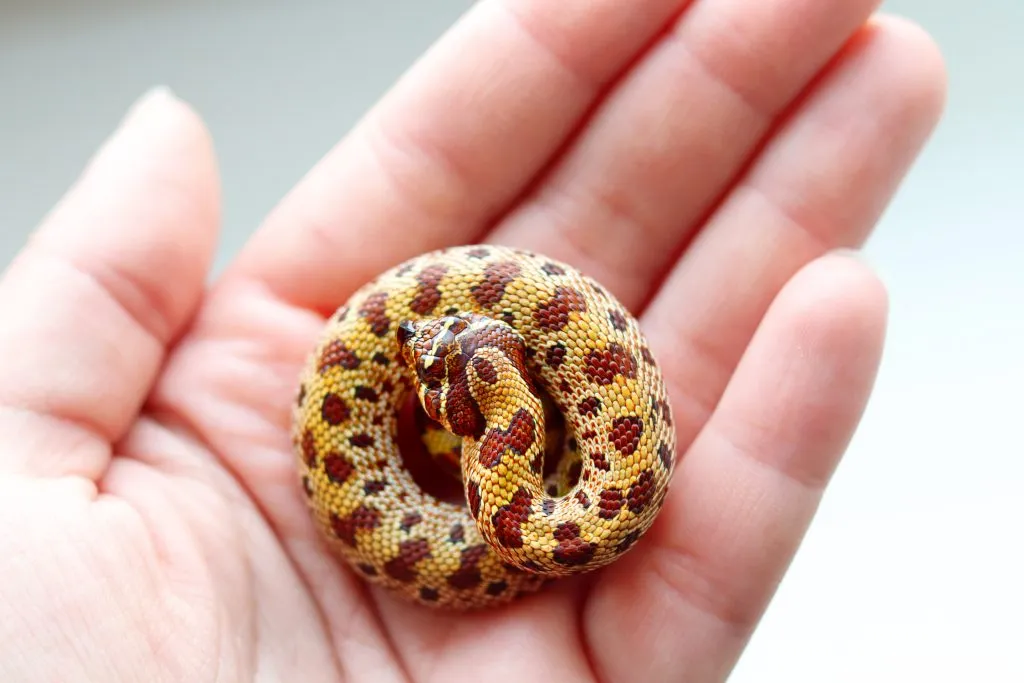
Western Hognose snakes can easily be mistaken as a rattlesnake due to the spots, blotches, and stripes that run across their bodies.
As for their bellies, based on the morph that they have, they usually have a solid color. For some that have a pattern or color morph, they can have a checkered or speckled belly.
The most striking feature of Western Hognoses is that they have an upturned snout which is not common to most pet snakes.
Also, compared to other snakes, they are stouter. Just like most snakes, females are significantly larger than males.
The most common morph is called the normal or wild morph. The body has brown, white, and tan lines while the belly is solid black.
The most sought-after morph is the albino morph. Depending on the color morph of the albino, it may appear yellow or pale yellow with white and they also have red eyes.
Here are other morphs of the Western Hognose snake:
- Lavender
- Axanthic
- Lemon Hypo
- Conda
- Red
- Snow
- Jaguar
How Big Do Western Hognose Snakes Get?
Female western hognoses can grow up to 2.5-3 ft., while their male counterparts are 1.5-2 ft. As you can see, compared to other snakes, they do not grow so big.
This is also the reason why they are famous snake pets, as they do not need massive spaces.
Baby western hognoses are usually 5-7 inches long, and they do not grow rapidly. They start to increase their size as juveniles in their 4th-5th month, and they will approach their final adult size at one year old.
Western Hognose Snake Lifespan
Western Hognose snakes can live for 15-18 years in captivity. There are some owners that have 20-year-old western hognoses, but these cases are rare.
For the most part, if they are properly cared for and do not have any diseases, their maximum lifespan is 18 years.
How To Care For Western Hognose Snakes
In general, Western Hognoses are not difficult to take care of once you get the heating right. However, they are notorious for being picky eaters.
This is also the reason why this is an intermediate-level snake, as you need to employ certain tactics to make them eat properly.
Western Hognose Snake Tank Setup
As your Western Hognose grows, you should also change the size of the enclosure based on its current size.
Therefore, for the first few months, it is not practical to get a glass enclosure since you will change into other enclosures later on.
Here are the enclosure sizes based on the size of the snake:
| Western Hognose Size | Tank Dimensions | Tank Size | |
| Hatchling (5-7 in.) | 16x8x10 in. | 5 gallons | |
| Juvenile (8-11 in.) | 20x10x12 in. | 10 gallons | |
| Adult Male: 18-24 in. Female: 30-36 in. | Male: 30x13x13 in. Female: 36x18x16 in. | Male: 20 gallons Female: 40 gallons |
If you got a hatchling, you could house it in an acrylic tank like this one. After two to three months, you can move it into a bigger tank.
Finally, once your western hognose turns one year old, it is time to switch to another
Lighting And Temperature
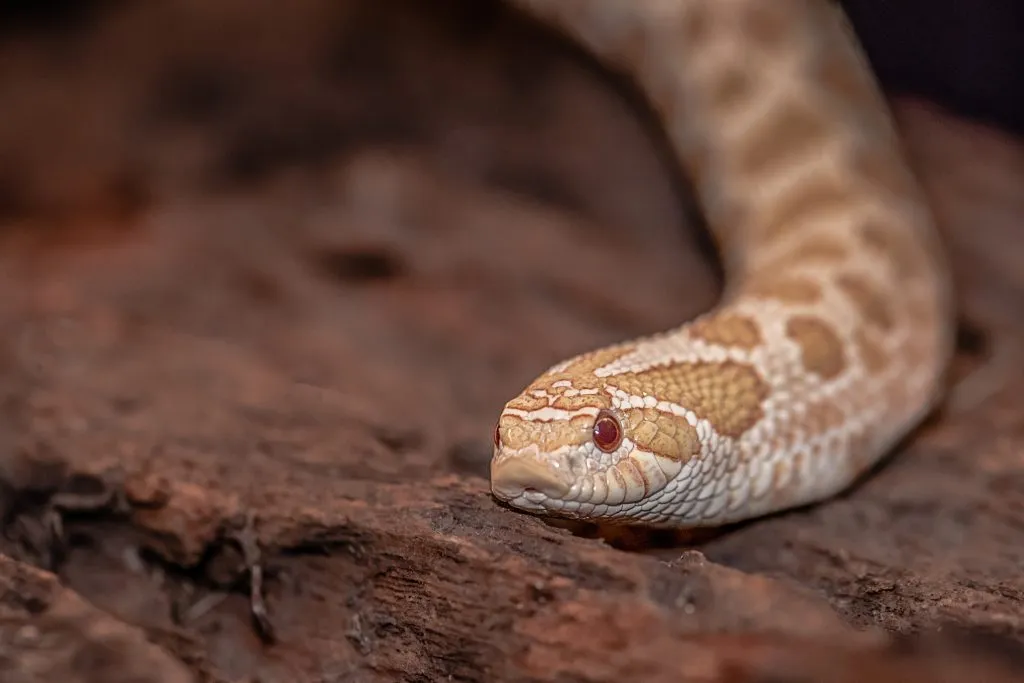
Western Hognose snakes are diurnal which means that they are active during the day and they rest at night.
Therefore, to mimic their natural sleep cycle, there should be 12 hours of daytime (lights on) and 12 hours of nighttime (lights off).
You do not need to install a separate light in the enclosure, the light in the room will suffice especially if there are windows in the room. Just make sure to turn the lights off at night.
As for heating, it is important to have both a cool zone and a basking spot. The temperature of the basking spot should be 90-95 F.
The ambient temperature is 75-85 F and the cool spot should be 70-75 F. At nighttime a temperature drop of 65-75 F is okay, but it should not be below 60 F.
It is very popular to use a heat mat for snake enclosures. However, a heat mat can sometimes distort the ambient temperature in the enclosure.
Further, Western Hognoses love to burrow, and if they burrow too deep, they may be burned if the heat mat is placed underneath.
A good alternative for heating is to use a halogen heat lamp. This will ensure that the warm zone of the enclosure will maintain its temperature.
Make sure to monitor the temperature gradient of the enclosure by using an infrared thermometer to avoid overheating.
Do Western Hognose Snakes Need UVB?
Western Hognoses can survive without UVB in captivity. However, it is still good practice to provide them with UVB for proper Vitamin D3 synthesis and for improving cognitive and digestive functions.
For this, we highly recommend the Zoo Med Reptisun Compact 5.0. In our review here, you will find out that it has a consistent UVB output that you can create your desired Ferguson zone easily.
In the case of Western Hognoses, they are in Ferguson Zone 2, which has a UVI range zone of 0.7 – 1.0.
In order to calibrate this properly when setting up the enclosure, you need a UVI meter just like this one to know where you should place the hide and the basking spot.
Substrate
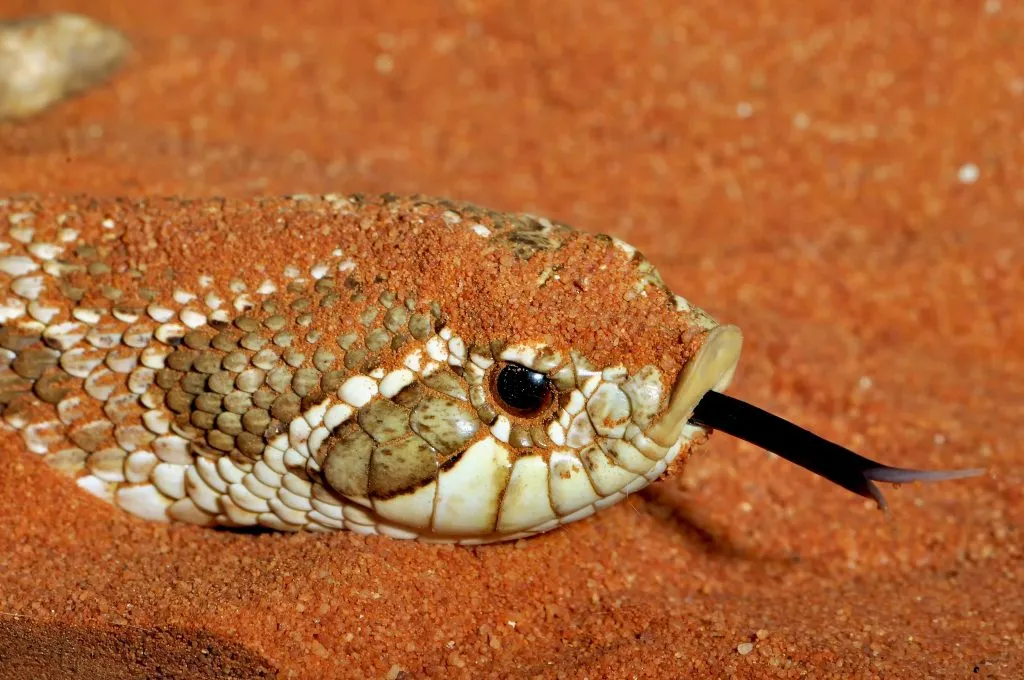
Western Hognoses love to burrow, therefore, they need to have at least 3 in. of the substrate. If you have a bigger snake, it can be 4-5 in. Here are some good options:
- Aspen shavings/chips (good for hatchlings)
- Bioactive substrate (perfect for adults as you do not need to change enclosures anymore)
- Sphagnum moss and fir shavings mix
- Sand and soil mix (70% soil and 30% sand)
These are not good substrate options:
- Gravel
- Coconut fiber
- Cedar/pine bark shavings
- Newspaper
- Toilet paper
You can use toilet paper (not shredded) when you are going to quarantine your snake. It can also be used if you have a hatchling and you have yet to prepare its enclosure.
Toilet paper is not a good choice as it does not provide enrichment to your Western Hognose.
Humidity
Western Hognoses thrive in an enclosure with low humidity. The ideal condition is that the moisture is held underground compared to being in the air. The average humidity in the enclosure should be 30-50%
You can check the humidity by using a hygrometer. In order to maintain the humidity, you just need to mist the substrate once a week.
You can use a spray mister just like this one. If you have a bioactive setup, do not forget to spray the plants.
Western Hognose Snake Tank Decor
You should put a hide in the enclosure so your Western Hognose has a place to feel secure. It can be a simple plastic hide like this one that is used by many snake owners.
In choosing a hide just make sure that the holes are big enough for the entire body of your Western Hognose to slide through.
You can also add climbing branches, cork hollows/flats, and leaves. Do not overcrowd the enclosure, as Western Hognoses prefer to burrow compared to climbing surfaces.
How To Clean A Western Hognose Snake Tank
In order to prevent the spread of bacteria, it is ideal to spot-clean the enclosure every day.
Whenever your Western Hognose poops, you should immediately remove it. You should also wash the water bowl twice a week or immediately after it is soiled.
For spot cleaning, you can wipe the sides of the enclosure by using a damp cloth. Every 4 weeks, you should do a deep clean. Make sure to move your snake to a temporary bin that has air holes in it.
Remove the substrate and the accessories. Spray the accessories with a disinfectant and wash the enclosure with water and disinfectant.
You can leave it for 10 minutes before rinsing and completely drying everything before putting it all back. It is good practice to replace the substrate with every deep cleaning.
Western Hognose Snake Diet
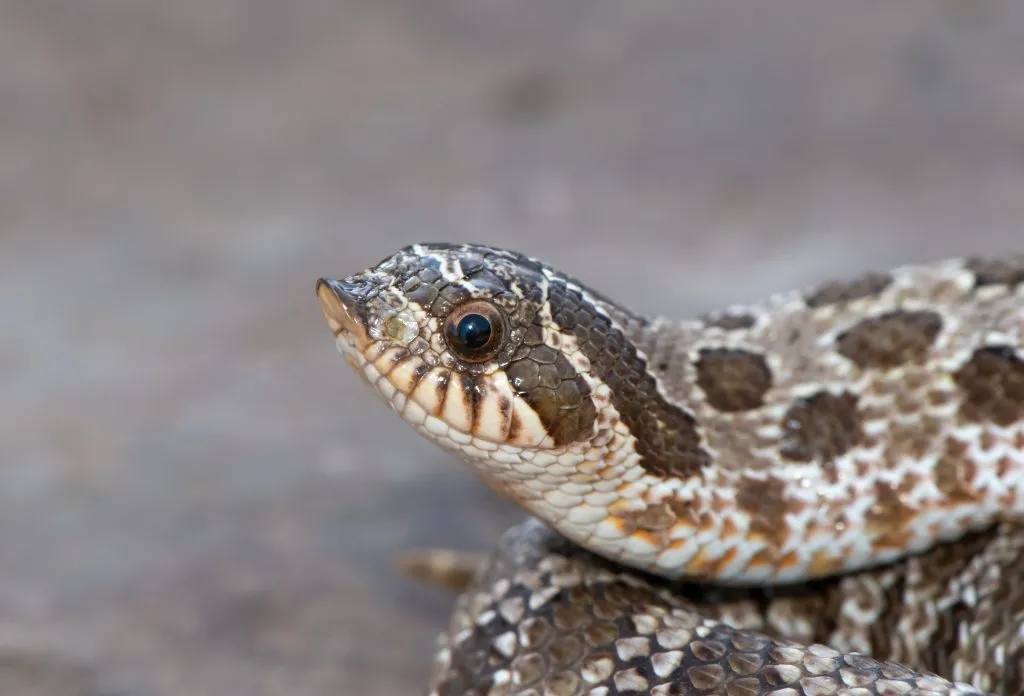
Western Hognose snakes are notorious for being picky eaters. There are cases when they refuse to eat even if there is nothing wrong with them.
Let us discuss the feeders that you need to prepare and the ways how to feed them.
What To Feed
Western Hognoses are carnivores, so you should never feed them fruits and vegetables. In the wild, their diet mainly consists of frogs and toads, but in captivity, they do well with a diet of rodents.
What is important is to also give your Western Hognoses variety, so they do not get tired of their
- Pinky mouse/rat pups
- Cuban tree frogs
- Gray treefrogs
- Quail eggs
- Axolotls
- African clawed frogs
- Frozen/thawed anoles
- Caned toads
- Dropped gecko tails
It is best to provide them with frozen and thawed feeders compared to live ones to negate the risk of the feeder harming your snake.
In cases where your Western Hognose refuses to eat, you can scent the feeder with toads. If you already have toad feeders, you just scent a pinky by rubbing it against the toad.
You can also use frog-scenting liquid to urge them to eat. Offer the feeder to your snake by using tongs and wiggling it to mimic live prey.
How Often To Feed
Here is our recommended feeding schedule.
| Age | When To Feed |
| Juvenile | one pinky mouse (every 3-4 days) |
| Adult | 2-3 rat pups (4-5 days) |
If you are planning to give a variety of feeders, make sure to offer the other type of feeder on the next feeding schedule and not mix it with the current feeding.
For example, you want to give your adult Western Hognose quail eggs and rat pups.
You should not feed both feeders on their feeding day. Instead, you should wait for the next feeding day to offer it quail eggs. This is done to dissuade pickiness with eating
How Long Can They Go Without Food
Western Hognoses can survive for 1-3 months without
Western Hognoses are known for refusing to eat for up to a month when they simply do not feel like it.
This usually happens when you first bought it and it is still adjusting to its environment. It may also be in shed or about to shed or it is going into brumation.
Just keep offering
Do Western Hognoses Snakes Need Water?
Yes, Western Hognoses should always have a supply of water. You can just leave a shallow water bowl in its enclosure. It will automatically drink from it or even soak in it from time to time.
You can get this water bowl it is shallow enough to ensure that your snake will not accidentally drown in it but it is also spacious enough to hold water that can last for 2-3 days.
Vitamins And Minerals
There is a debate on whether you should give vitamins and minerals to Western Hognoses, but to be on the safe side, it is best to give vitamins and minerals to them once every 4 feedings.
To do this, you can lightly dust the feeder with Calcium powder.
On the other hand, it is good to dust the feeders of female Western Hognose breeders. Calcium is good for the eggs and there is a high chance that a whole clutch will hatch successfully with calcium supplementation.
Western Hognose Snake Behavior And Temperament
Western Hognose snakes earned the name “bluffer” as that is exactly what they do best. They can be very docile and easy to handle, but when they get anxious, they resort to bluff striking. They will flatten their heads, hiss, and strike at you.
They tend to bluff strike more compared to biting, but when they strike a bluff, they also leave a scent on your hand. It is rare for Western Hognoses to bite you for
They are mildly venomous, but their venom is not deadly to humans. It only affects those who have allergies to venom.
When constantly handled, they easily get used to their owner’s presence. It can even go up to the point that it can steadily chill around your arm while you are working or watching tv.
Wann learn more about how bad hognose snake bites are? Read our article on that here!
Are Western Hognose Snakes Good Pets?
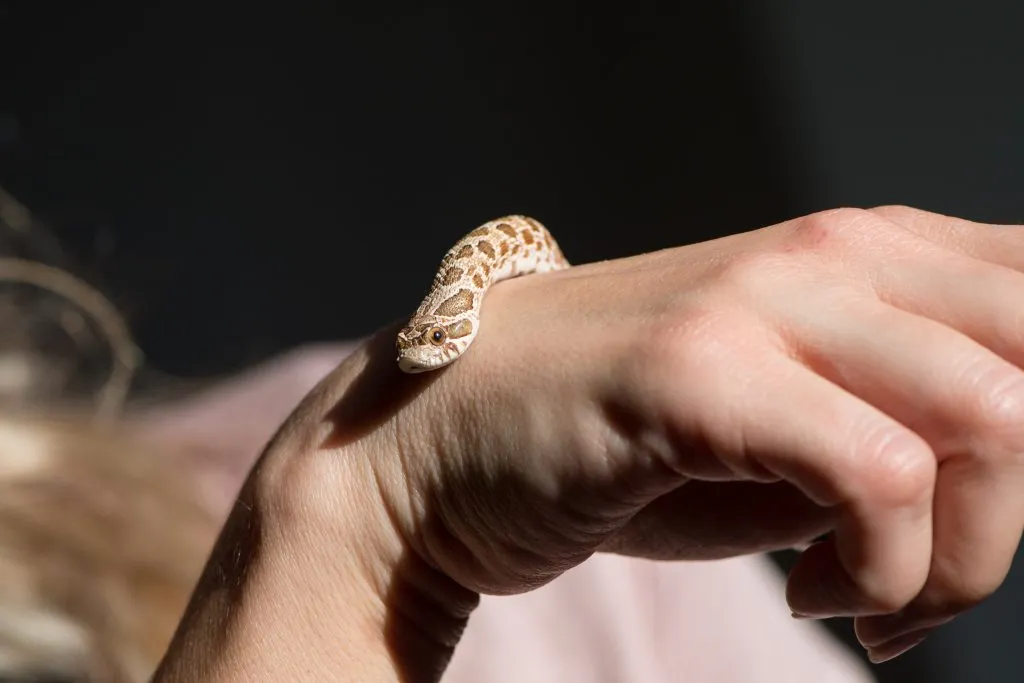
They are great pets once you establish a bond and they no longer get so anxious. The biggest problem with owning Western Hognoses is the fact that even the most minute of movements can make them act defensively.
They will either bluff strike at you, give you a few nips, or even play dead. This may be frustrating to first-time owners as they simply cannot handle the snake without it striking at them.
However, you just need to overcome this hurdle and with lots of training and patience, your Western Hognose will learn to calm down.
On the other hand, you also need a lot of patience in terms of feeding. They tend to be picky eaters so you really have to exhaust all strategies to make them eat.
But once they start eating, the next feeding schedule will be much easier.
Western Hognose Snake Common Health Problems
The biggest problem with Western Hognoses is that they get stressed easily. When they are always stressed, their immune system weakens, thus making them more susceptible to diseases. Here are their most common health problems:
- Impaction
Western Hognoses are messy eaters so they accidentally ingest some of the substrate. To avoid this, you can feed them using tongs.
- Anorexia
As they are picky eaters, they can go up for a month since getting them without
- Stomatitis
Western Hognoses have fragile gums and fangs. Therefore, a simple irritation in these areas can lead to serious infections.
- Respiratory Infection
This can be caused by the wrong humidity and temperature in the enclosure. Watch out for any wheezing, coughing, breathing with the mouth open, and bubbling of the nose.
Where To Buy Western Hognose Snakes

You should only buy from reputable breeders that do not sell wild-caught Western Hognose snakes.
It is not recommended to get them from commercial pet shops. Usually, the snakes found there are not adequately cared for. Reptile expos are a great place to find the morph that you want.
Western Hognose Snake Breeders
Here is a list of reputable breeders:
- Snake Discovery (they only sell snakes on-site as they also want to educate the owner on how to take care of the snakes, they also have adoption programs)
- Snakes at Sunset
- Underground Reptiles
- XYZ Reptiles
- Backwater Reptiles
Western Hognose Snake Price
The price of the Western Hognose snake is based on the morph that it has. If you want a rare morph, then it will be more expensive.
Western Hognoses that also do not look like their specific morph, but have rare morph genes also tend to be sold at a higher price.
The normal axanthic morph usually costs $199-$299 this can also include brown and toffee colors.
If you are on the lookout for albinos, snows, and lavenders, the range is $399-$474. In the case of the conda morph, the range is $549-$699.
Western Hognose Snake Breeding
If you plan to breed your western hognoses, you should first consider their age and weight. A one-year-old male is sexually mature and should weigh at least 70g. The female should be 2 years old and weigh 250g.
You should then brumate them to stimulate their breeding response.
After brumation, you get them back in their enclosure and gradually increase the temperature of their enclosures. By this time, the female will go through its ovulatory phase cycle and will be open to breeding.
You can then pair the two snakes and wait for them to breed. You should do this in rotation until you can visually confirm that the two actually mated.
Conclusion
Western Hognose snakes are the perfect pet snakes if you have lots of patience and you can endure a few bites during handling training.
They are easy to care for once you set up the enclosure properly and are armed with the right feeders. In no time, your Western Hognose will reward you with boops on the nose.
- Enchi Ball Python: A Unique and Stunning Morph of Python regius - March 27, 2025
- Emerald Tree Monitor: The Enigmatic Green Guardian of the Rainforest - March 26, 2025
- The Egyptian Cobra (Naja haje): A Fascinating Serpent - March 25, 2025
